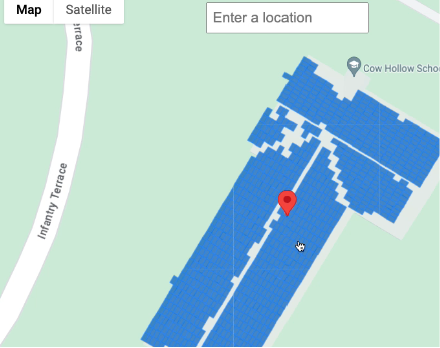Solar API sử dụng dữ liệu về địa điểm để xác định loại công trình và xác định các công trình dựa trên hình ảnh vệ tinh. Trang này mô tả cách xác định thông tin về năng lượng mặt trời của toà nhà nào được trả về trong yêu cầu buildingInsights.
Các loại toà nhà
Solar API hỗ trợ các toà nhà thuộc loại premise. Loại này cho biết một vị trí có tên, thường là một toà nhà hoặc một nhóm toà nhà có tên chung.
Các loại khác, chẳng hạn như subpremise hoặc các loại phức hợp (ví dụ: các toà nhà riêng biệt nằm trên một tài sản duy nhất, trừ phi được đăng ký là premise) không được hỗ trợ.
Mái nhà
Solar API xác định vị trí lắp đặt tấm pin năng lượng mặt trời tối ưu trên mái nhà dựa trên hình ảnh vệ tinh. Các toà nhà dân cư, đặc biệt là những toà nhà có mái dốc hoặc mái nghiêng, được xác định với độ chính xác cao, trong khi các toà nhà có mái bằng (ví dụ: toà nhà chung cư hoặc toà nhà thương mại) có thể có độ chính xác khác nhau.
Nếu phản hồi buildingInsights không có trường solarPanelConfigs, thì có nghĩa là toà nhà đã được xử lý đúng cách, nhưng chúng tôi không thể lắp đặt các tấm pin trên mái nhà. Điều này có thể xảy ra nếu mái nhà quá nhỏ để lắp đặt các tấm pin hoặc quá râm mát nên các tấm pin không thể tạo ra nhiều năng lượng.
Tìm kiếm từ một địa chỉ
Bạn có thể chuyển đổi một địa chỉ thành toạ độ vĩ độ và kinh độ bằng cách sử dụng Geocoding API hoặc Place Autocomplete API.
Sử dụng
place_idđể tham chiếu đến địa điểm phù hợp.Sử dụng toạ độ vĩ độ và kinh độ của địa điểm trong yêu cầu Solar API
buildingInsights.- Nếu Solar API tìm thấy một toà nhà phù hợp, hãy kiểm tra để đảm bảo rằng
place_idtrong phản hồibuildingInsightskhớp vớiplace_idtừ Geocoding API hoặc Place Autocomplete API. - Để giới hạn kết quả ở những địa điểm có loại
premise, hãy thêm bộ lọc loại địa điểm vào các phản hồi của Geocoding API hoặc Places API.{ "name": "buildings/ChIJh0CMPQW7j4ARLrRiVvmg6Vs", "center": { "latitude": 37.4449739, "longitude": -122.13914659999998 },... }
- Nếu Solar API tìm thấy một toà nhà phù hợp, hãy kiểm tra để đảm bảo rằng
Bạn có thể sử dụng ứng dụng mẫu nguồn mở hoặc đưa ra yêu cầu buildingInsights để kiểm tra place_id cho các toà nhà thuộc phạm vi của Solar API.
Chọn vị trí trên bản đồ
Bạn cũng có thể cung cấp trải nghiệm bổ sung bằng cách cho phép người dùng chọn toà nhà trên bản đồ bằng Maps JavaScript API. Trích xuất vĩ độ và kinh độ của toà nhà từ sự kiện chuột, sau đó truyền các toạ độ đó vào một yêu cầu buildingInsights.


